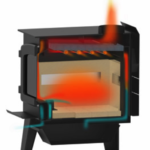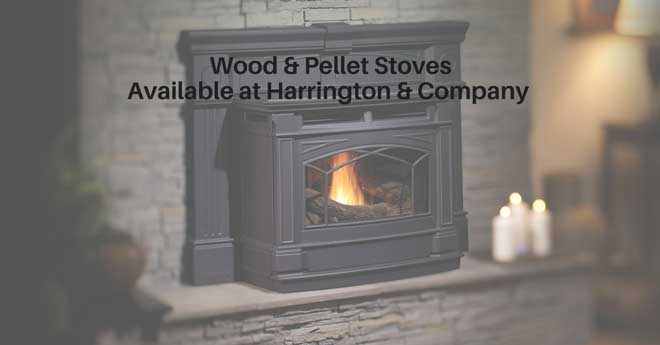Harrington & Co decided to stock wood and pellet stoves several years ago. We originally only had them available at our Rock Springs, Wyoming location.
After some success there, we decided that it would be a good idea to have these great products at all five of our locations. The stove that we decided to stock is made by Drolet’. This is a French-Canadian product built in the great white north where they have to build the stoves to conquer the harsh cold winters.
Our Drolet’ wood burning stoves start at under $1000. We have several different models on hand, with different BTU ratings, so that you will have plenty of options to heat the space that you need.
Those of you that would like to have a pellet stove, we have a couple of different options available. We also are one of the mountain west’s leading distributors of wood pellets. We only sell high quality, low waste pellets. We buy from two different manufacturers. Woodscapes (made in Salt Lake City) and Redi-Heat (made in southeastern Idaho). Both companies make a high heat burn, low ash pellet for maximum efficiency.
For those of you who worry about the impact that burning wood has on the environment, here’s an interesting article that you will find helpful:
Wood and Pellet Stove: a carbon-neutral source of heating

When oil, gas, and coal are burned, the carbon they contain is oxidized to carbon dioxide (CO2), the main greenhouse gas. In effect, the combustion of fossil fuels releases ancient carbon (carbon that has been buried within the earth for thousands of years), thereby increasing the atmospheric concentration of carbon dioxide (CO2). In comparison, wood combustion can be considered carbon neutral because trees absorb CO2 as they grow. This process is called carbon sequestration. Approximately one ton of carbon is

sequestered for each cubic meter of wood. When trees mature, die, fall in the forest and decompose, the same amount of carbon is emitted as would be released if they were burned for heat. This cycle can be repeated forever without increasing atmospheric carbon. A healthy forest is not a museum, but a living community of plants and animals. When trees are used for energy, a part of the forests carbon “bank” is diverted from the natural decay and forest cycle into our homes to heat them.
When we heat with wood, we are simply tapping into the natural carbon cycle in which CO2 flows from the atmosphere to the forest and back. The key to ecologically sound and sustainable wood energy use is to ensure that the forest remains healthy, maintains a stable level of variously aged trees and provides a good habitat for a diversity of other species, both plants, and animals. Ensuring there is a healthy fuelwood market is a key to a sustainable forestry plan. Landowners have more incentive to remove low-value trees and manage their forests sustainably knowing there is a market for this low-value material

The combustion of wood produces small particles that are called PM2.5. Those particles are 30 times smaller than a human hair. They can aggravate certain lung and heart diseases and have been linked to health problems such as asthma. Sources of PM2.5 include combustion under various forms, such as the one used for cars and trucks, wood heating, as well are other industrial processes. While it is true that old technology like open fireplaces and simple heaters could not burn the wood completely, the new generation of wood-burning appliances is designed to burn particles. They produce almost no visible smoke. The wood-heating industry has evolved. The vast majority of appliances sold on the market now meet the particles emissions limits set by the US Environmental Protection Agency as well as the Canadian standard CSA B415.1-10 For example, the Environmental Protection Agency, better known as EPA, limits emissions of certified wood heating appliances to no more than 4.5 grams per hour. In comparison, older conventional wood stoves average 40 grams per hour. Numerous countries, provinces, and municipalities, have adopted laws that regulate the sale of wood-heating appliances that do not meet the latest standards in terms of particles emissions. Among them, we can name the United States, Australia, New Zealand, as well as numerous countries that are part of the European Union. In Canada, British Columbia, Quebec, Nova Scotia, and Newfoundland have also introduced laws regulating the sale of wood-heating appliances.
Wood, when burned in an appliance that has been tested to the EPA or CSA B415.1-10 standards, emits up to 80% fewer particles. It is a clean, renewable energy source. Furthermore, the reduction in fuelwood consumption reaches up to 30% when advanced wood combustion systems are used. This is because certified wood stoves and fireplaces

are 60% to 80% efficient, compared with 40% to 60% for conventional units. As for appliances burning wood pellets, they have amongst the lowest particulate emissions of all solid-fuel burning appliances. They are manufactured from waste products and other renewable resources right here in North America. They represent a huge source of heating fuel from the material that would otherwise be sent to landfills.
All Drolet EPA wood appliances have a secondary air source. Heated air flows, which are circulated through perforated channels located under the firebox baffle, allow for a complete combustion of particulates before they are released into the atmosphere. You burn less wood and help the environment.

